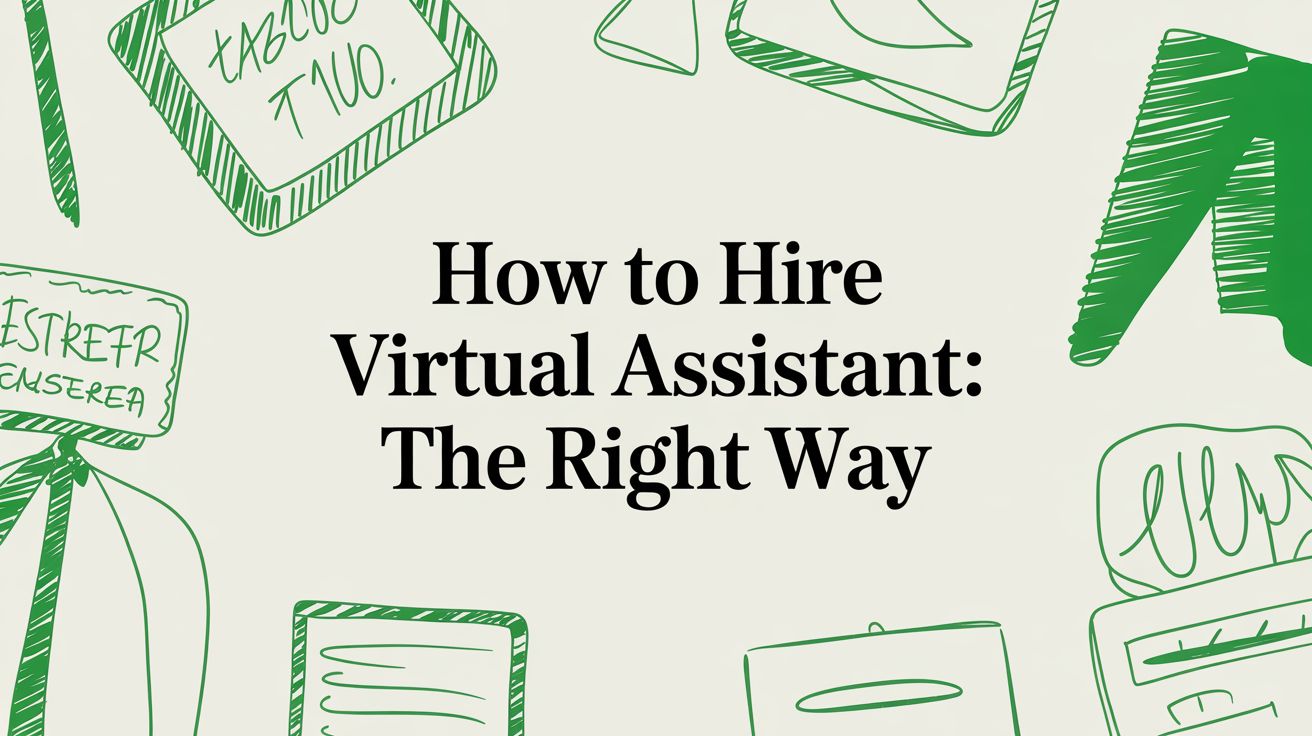Before you even start looking for a virtual assistant, the most important work happens right at your own desk. It all begins with getting crystal clear on what you actually need help with. This isn’t just about feeling overwhelmed; it’s about methodically identifying tasks, creating a detailed profile for the role, and then deciding where to find your perfect match.
Getting this foundation right is, without a doubt, the single biggest factor in making a successful, long-term hire.
Laying the Groundwork for a Successful Hire

Before you post a job ad or reach out to an agency, you need to get brutally honest about where your time is going. Just saying “I need help” is far too vague and often leads to a mismatched hire and frustration on both sides. The real goal is to turn that general feeling of being swamped into a specific, actionable list of tasks you can hand off.
The best way to do this? A simple, one-week time audit. Keep a log of every single thing you do. Pay close attention to the activities that drain your energy, the ones that are purely repetitive, and those that don’t directly drive revenue or growth for your business.
Pinpoint Your Delegation Priorities
It’s a common story: entrepreneurs and leaders spend over a third of their week tangled up in small administrative tasks that pull them away from the big picture. I’ve seen it countless times—a brilliant marketing consultant who loses hours every week manually scheduling social media posts, or an agency owner who gets bogged down creating weekly client reports instead of nurturing new leads. These are prime candidates for delegation.
Your time audit will probably reveal some clear patterns you hadn’t consciously noticed before.
- Administrative Overload: Answering the same emails over and over, juggling your calendar, and trying to keep digital files organized.
- Marketing Mechanics: Updating your CRM, prepping email newsletters for launch, or pulling basic analytics reports.
- Operational Drag: Chasing down late payments, handling invoicing, or managing day-to-day bookkeeping entries.
To get started, here is a quick breakdown of common business functions and the kinds of tasks that are perfect for a virtual assistant.
Identifying Tasks to Delegate to a Virtual Assistant
| Business Function | Example Tasks for a VA |
|---|---|
| Executive & Admin Support | Calendar management, email filtering, travel booking, data entry, document formatting. |
| Marketing & Social Media | Scheduling posts, creating graphics, formatting newsletters, community management. |
| Sales Support | CRM updates, lead qualification, appointment setting, preparing sales reports. |
| Operations & Finance | Invoicing, expense tracking, customer service inquiries, project management updates. |
| Content & Communications | Blog post formatting, proofreading, transcription, creating presentation slides. |
Thinking through these categories can help you quickly build a concrete list of responsibilities.
By identifying these time-draining activities, you’re not just offloading work; you’re buying back your most valuable asset—time—to focus on strategy, sales, and innovation. This is the first and most crucial step in mastering virtual hiring.
From Task List to Role Profile
With a solid list in hand, you can start grouping similar tasks to build the core of a role. Suddenly, that scattered list of chores starts to look like a real job description. For instance, “email management,” “calendar scheduling,” and “travel booking” naturally combine into an Executive Assistant role. Likewise, “social media scheduling,” “blog formatting,” and “newsletter creation” clearly point toward a Marketing Assistant.
This clarity is what helps you define the specific skills you’ll need. Does your ideal candidate need to be a wizard with QuickBooks, or is deep experience with Mailchimp the real priority?
The world of virtual assistance has come a long way. By 2025, it’s estimated that 40% of VAs will offer highly specialized services in complex fields like IT and legal support. We’re already seeing this shift, with 40% of digital marketing agencies now relying on VAs for sophisticated campaign management.
This is where working with a U.S.-based outsourcing partner can make a huge difference. They often provide expert consultation to help you analyze your workflows and pinpoint the exact tasks that will give you the highest ROI when delegated. That kind of strategic guidance ensures you hire for maximum impact, not just to fill a seat. You’ll walk away with a clear, detailed profile of your ideal VA, defining not just what they’ll do, but the tangible difference they’ll make for your business.
2. Where to Find Your VA: Freelance Platforms vs. US Partners

Once you know who you’re looking for, the next big question is where to find them. The market is full of options, but they really boil down to two main paths: hiring directly from a giant freelance marketplace or teaming up with a managed service partner.
Each route has its own set of pros and cons, and the right choice depends entirely on how much time and risk you’re willing to take on yourself. This decision is more than just a logistical one; it will define how you manage and integrate your new VA into your business.
Going Direct: The Freelance Platform Approach
Platforms like Upwork and Fiverr are popular for a reason—they give you access to a massive global talent pool with just about any skill you can imagine. If you want total control over the hiring process, this is it. You write the job post, you set the budget, you screen every single applicant.
But that control comes at a cost, and that cost is your time.
When you hire directly, you’re not just a manager; you’re also the recruiter, HR department, and payroll administrator. You’ll be the one sifting through potentially hundreds of applications, conducting interviews across different time zones, and trying to verify skills and references on your own. It’s a huge time sink.
On top of that, you’re on the hook for handling contracts, international payments, and tax compliance. The risk of making a bad hire and having to start the entire draining process over again rests squarely on your shoulders.
The Smart Alternative: Partnering with a US-Based Agency
Working with a US-based outsourcing partner like NineArchs completely changes the game. Instead of just hiring a person, you’re gaining a full support system. This model is built for busy leaders who can’t afford to get bogged down in the minutiae of recruiting.
A good partner does all the heavy lifting. They tap into their proven talent network to source, screen, and vet candidates who are already pre-qualified for the role you need to fill. This drastically cuts down your time commitment and, more importantly, reduces the risk of a mis-hire. The key benefit of a USA partner is the layer of accountability and support they provide, ensuring your business operations are always protected.
The real value of a US partner is the built-in accountability and quality control. They manage the legal contracts, payroll, and compliance, taking that entire administrative burden off your plate.
This structure frees you up to focus on what actually matters: integrating your new VA into your team and getting them up to speed on your business. When you look into the details of platforms like Upwork vs Fiverr, you quickly realize just how much administrative work is involved compared to a managed service.
Why Cultural Alignment and Communication Matter
One of the biggest, yet often overlooked, advantages of a US-based partner is ensuring seamless cultural and professional alignment. They specialize in finding talent that not only has the right skills but also inherently understands American business etiquette, communication styles, and work ethic.
This shared context gets rid of the friction that can come from mismatched expectations or communication breakdowns across different cultures and time zones. Your VA integrates faster, feedback is understood more clearly, and you can hit the ground running.
Plus, a US partner provides a critical safety net. What happens if your freelancer gets sick or goes on vacation? With a direct hire, your work grinds to a halt. A partner, on the other hand, can provide a trained backup, ensuring business continuity.
This kind of reliability is something freelance platforms simply can’t match. To learn more about how a managed provider delivers both top-tier talent and peace of mind, see what a partnership for outsourced virtual assistants can look like.
Writing a Job Description That Attracts Top Talent

Think of your job description as a sales pitch, not a shopping list. It’s your first and best chance to sell your company to the exact candidates you want to hire. A generic, uninspired post will only attract generic, uninspired applicants.
To really stand out, you have to go beyond the usual templates. You need to craft a description that tells a story and resonates with high-caliber professionals. A great job post acts as a filter, weeding out mismatched candidates before they even click “apply.”
Craft a Title and Company Overview That Connects
The job title and your company summary are the first things a candidate sees. If they don’t connect, you’ve already lost them. They’ll just keep scrolling.
Start with a title that is clear, professional, and uses standard industry terms. This is not the place for quirky titles like “Productivity Ninja.” Stick to searchable, recognizable terms like “Executive Virtual Assistant” or “Marketing Support Specialist” to ensure you show up in the right searches.
Next, write a brief but compelling company overview. This is your moment to showcase your mission, values, and culture. Don’t just state what you do; tell a story.
- Weak Overview: “We are a fast-growing digital marketing agency looking for a virtual assistant.”
- Strong Overview: “We’re a boutique marketing agency dedicated to helping sustainable e-commerce brands find their voice. As a small, collaborative team, we value proactive communication and a shared passion for making a positive impact.”
See the difference? The second example immediately connects with candidates who share those values, attracting a much better cultural fit right from the start.
Define Responsibilities with a Focus on Outcomes
This is where most job descriptions fall flat. They list vague, passive duties instead of describing the real-world impact of the work. Top-tier VAs aren’t looking for a to-do list; they want to know how their contributions will move the needle for your business.
Think through a typical day or week for the role and translate those activities into tangible outcomes. Frame each responsibility to show what “a job well done” actually looks like.
A common mistake I see is being too vague about what “done” means. For instance, instead of just “manage social media,” a much better description would be, “Schedule, post, and report on weekly social media content across LinkedIn and Twitter, aiming to increase engagement by 10% each quarter.” This clarity empowers your VA and sets clear expectations from day one.
When you partner with a US-based outsourcing firm, they often help you hammer out these details. Their experience is invaluable for defining the role with precision, which helps attract candidates who are already aligned with American business communication styles and performance metrics.
An Annotated Example: Passive vs. Active Descriptions
Let’s look at how a few small tweaks can completely change the feel of a job description. A passive, task-based list might look like this:
- Handle email inbox
- Schedule meetings
- Update CRM
Now, let’s reframe that into an active, outcome-focused version:
- Manage executive inbox: Proactively filter, prioritize, and respond to emails, ensuring a response time of under 24 hours for all critical inquiries.
- Coordinate executive calendar: Schedule internal and external meetings across multiple time zones, preparing agendas and necessary materials in advance.
- Maintain CRM database: Ensure all client and lead information in HubSpot is accurate and up-to-date daily, generating a weekly pipeline report for the sales team.
The active version instantly shows a candidate that they will be a vital part of the team’s workflow, not just a task-doer.
The Pro Tip for Identifying Detail-Oriented Candidates
Finally, here’s a simple trick I’ve used for years to instantly find candidates who actually read the description.
Embed a small, specific instruction somewhere in the job post. It can be anything, like, “In your cover letter, please mention your favorite productivity tool and why you like it,” or “Start your application subject line with the phrase ‘VA Application – [Your Name]’.”
Candidates who follow this simple instruction prove they’re detail-oriented and have read your post carefully. It’s an incredibly effective, low-effort filter that can save you hours of screening time and helps you hire the right virtual assistant.
Mastering the Interview and Vetting Process
You’ve got a pile of promising applications, which is great. But a polished resume doesn’t tell the whole story. Now comes the part where you separate the good-on-paper candidates from the genuinely great hires. This means creating a deliberate vetting process that peels back the layers to see their real skills, work ethic, and how they think on their feet.
The first pass is all about efficiency. Your goal is to quickly trim the long list down to a manageable shortlist. Focus on weeding out anyone who clearly missed the mark on the baseline requirements you set in your job description. Remember that specific instruction I suggested putting in your job post? This is where it pays off big time, immediately filtering out those who don’t pay attention to detail.
Asking Questions That Reveal True Capabilities
Once you have your shortlist, it’s time to talk. The goal of the interview isn’t to hear rehearsed answers to stale questions. Forget about asking, “What are your biggest weaknesses?” It’s time to dig deeper with questions that show you how a candidate actually operates.
The best way to do this is with behavioral and situational questions. They force candidates to think critically and draw on real experiences, which tells you volumes about how they handle pressure, solve problems, and communicate.
- Behavioral Question Example: “Tell me about a time you had to solve a problem with very limited information or guidance. What steps did you take, and what was the outcome?” This gets right to their resourcefulness and initiative.
- Situational Question Example: “Imagine you have three urgent tasks from different managers, all due by the end of the day. How would you prioritize them, and how would you communicate your plan?” This is a fantastic test of their prioritization and communication skills under fire.
There’s no single “right” answer here. What you’re listening for is their thought process, how clearly they explain their logic, and the professional maturity they bring to the situation.
The Ultimate Litmus Test: The Paid Trial Task
No matter how impressive someone is in an interview, nothing beats seeing their work firsthand. That’s why I consider a paid trial task a non-negotiable final step. This isn’t some generic skills quiz; it’s a small, real-world project that reflects what they’ll actually be doing day-to-day.
For instance, if you’re hiring a VA to run your social media, ask them to create a week’s worth of content for one platform, repurposing a recent blog post. If the role is heavy on customer support, give them a few sample customer emails and have them draft the replies.
This paid trial is the single most effective way to see a candidate’s work habits, communication style, and ability to follow instructions before you make a commitment. It shifts the evaluation from theory to reality, dramatically cutting your risk of a bad hire.
This is exactly where working with a USA-based outsourcing partner can be a game-changer. They live and breathe this stuff. They have sophisticated interview and trial task systems already built, run by HR pros who know all the right signals to look for. This approach saves you dozens of hours and means that any candidate who makes it to your desk has already been meticulously screened for skill, reliability, and fit. That level of due diligence is one of the biggest advantages of using a managed service.
The global virtual assistant market is exploding—it’s projected to hit $19.5 billion by 2025, with small and medium businesses driving much of that growth. As demand soars, knowing how to hire virtual assistant candidates who can truly deliver is more critical than ever. You can read more about these virtual assistant industry trends and their impact to understand the landscape. A structured vetting process is your key to tapping into this incredible talent pool successfully.
For more insights on building your team, check out our guide on how to hire top candidates.
Setting Up Your New VA for Long-Term Success

The hiring process isn’t really over once a contract is signed. In fact, what you do next is arguably the most critical part. A thoughtful, structured onboarding plan is what turns a short-term helper into a long-term, strategic asset who genuinely contributes to your growth.
So many business owners make the classic mistake of throwing their new VA into the deep end on day one. They’re usually overwhelmed themselves and just desperate for immediate relief. But this approach almost always backfires, leading to confusion, mistakes, and a partnership that fizzles out fast.
A successful partnership is built on a foundation of clarity. That foundation starts with a solid roadmap for their first 30 days and beyond.
Laying the Groundwork in the First Week
The first few days should be all about orientation, not a mountain of tasks. Your main goal is to get the tactical essentials right. This means making sure they have access to all the necessary tools, software platforms, and communication channels like Slack or Microsoft Teams.
Give them key documentation right away. This isn’t just about sharing login credentials; it’s about empowering them with the resources they need to understand your business without pinging you with questions every five minutes.
- Essential Documents to Share:
- A Brand Guide: This should outline your company’s mission, tone of voice, and any visual guidelines.
- Contact List: A simple “who’s who” in your team, explaining their roles and how they might interact.
- Standard Operating Procedures (SOPs): If you have existing process docs for key tasks, share them. If not, this is the perfect opportunity to start building them together as you train.
This initial setup period is also the best time to lock in your communication protocols. Will you have a quick daily check-in on Slack? A weekly video call to recap and plan? Defining this rhythm from the get-go prevents a world of misunderstanding down the line.
Phased Training for Real Growth
A great VA doesn’t just check off a to-do list; they take ownership. To get them to that point, you need a phased training plan that empowers them to take on more responsibility over time, not all at once.
Start them off with simple, low-risk tasks to build their confidence and help them get comfortable with your systems. As they nail the basics, you can gradually introduce more complex responsibilities.
For example, in week one, they might just be formatting a blog post in WordPress. By week four, they could be doing keyword research and outlining the entire article. This slow-burn approach prevents them from feeling overwhelmed and gives you plenty of opportunities to offer feedback and make small corrections early on.
This is another spot where a USA-based outsourcing partner can make a huge difference. They often have proven onboarding frameworks already in place and provide ongoing coaching. This ensures your VA’s skills grow right alongside your business needs, without you having to manage every single step of their development.
Essential 30-Day VA Onboarding Checklist
To keep everything on track, a structured plan for the first month is a lifesaver. This checklist ensures all the critical bases are covered and you’re truly setting your new virtual assistant up for success.
| Week | Key Goals | Action Items |
|---|---|---|
| Week 1 | Integration & Access | Grant access to all tools, introduce them to the team, review the brand guide, and assign the first few simple tasks. |
| Week 2 | Core Task Training | Begin training on their primary responsibilities, establish a firm communication rhythm, and hold the first one-on-one feedback session. |
| Week 3 | Building Autonomy | Assign a multi-step project, encourage them to start documenting processes, and check in on their workload and overall clarity. |
| Week 4 | Performance Review & Future Planning | Review first-month KPIs, have an open discussion about what’s working and what’s not, and set clear goals for the next 90 days. |
This simple framework provides structure for both you and your VA, making the first month productive instead of chaotic.
Fostering a Sense of Belonging
At the end of the day, a VA is more than just a contractor; they are a member of your team. Making them feel like they belong is crucial for long-term retention and commitment. Be sure to include them in relevant team meetings, share company wins, and always connect their work to the bigger picture.
When your VA understands why a task is important—how it helps a client or contributes to a major business goal—their engagement and investment in the outcome increase dramatically. They shift from being a task-doer to a proactive problem-solver.
Finally, set clear Key Performance Indicators (KPIs) right from the start. For a marketing VA, a KPI might be to “increase social media engagement by 10%.” For an administrative VA, it could be “maintain a 24-hour response time on all priority emails.”
These metrics remove any ambiguity and give both of you a shared definition of what success looks like. This proactive approach doesn’t just accelerate their ramp-up time; it builds the trust you need for a lasting, successful partnership.
Common Questions About Hiring a Virtual Assistant
Bringing a virtual assistant onto your team for the first time naturally comes with a lot of questions. It’s a big step, and you want to get it right. From what it’ll cost to how you’ll manage them, getting the details ironed out beforehand is the key to a successful partnership.
Let’s walk through some of the most common questions business owners have when they’re ready to hire a VA.
How Much Does It Cost to Hire a Virtual Assistant?
This is usually the first question on everyone’s mind, and the answer is: it depends. The cost for a virtual assistant can swing wildly based on their location, skills, and years of experience. You might find someone on a large freelance marketplace for as little as $10 an hour for basic administrative tasks. On the flip side, a highly specialized, US-based executive assistant can easily command $75 an hour or more.
This is where working with a USA-based outsourcing partner really changes the game. Instead of gambling with fluctuating hourly rates, you get a predictable, fixed monthly fee.
But that fee covers so much more than just your VA’s time. It’s a bundled service designed to save you headaches and hidden costs down the road. Think of it this way—the fee typically includes:
- Serious Vetting and Recruitment: They find, screen, and test candidates, a process that can eat up dozens of your own hours.
- Ongoing Management and Quality Control: A dedicated manager is there to make sure performance is always on point.
- Built-in Backup Support: If your VA is sick or on vacation, a trained backup is ready to step in. Your business doesn’t skip a beat.
This model gives you a clear, predictable investment and a much higher level of reliability than going it alone.
What Legal Considerations Should I Be Aware Of?
When you hire a freelancer directly, you’re not just the client—you’re also the legal and administrative department. That means it’s on you to draft a rock-solid independent contractor agreement that spells out everything from the scope of work to confidentiality and who owns the intellectual property.
And then there’s the tax side. You’ll be responsible for collecting a W-9, tracking payments, and issuing a 1099 form at the end of the year for any US-based contractors. It’s another administrative loop you have to manage.
This is a huge reason why many businesses prefer to engage a US-based partner. They take this entire burden off your plate. They handle all the contracts, payroll, and tax compliance, shielding you from potential liability. You get to focus on the work, not the paperwork.
How Do I Effectively Manage a Remote VA?
The secret to managing a remote VA isn’t about watching their every move. In fact, micromanaging is the fastest way to kill morale and productivity. It’s all about having clear systems, consistent communication, and focusing on results.
First, get your tools in order. A project management platform like Asana, Trello, or ClickUp is non-negotiable. It creates a central hub for tasks, deadlines, and progress, so everyone is on the same page.
Next, establish a communication rhythm. Maybe it’s a quick daily check-in on Slack and a more strategic weekly video call. Whatever you choose, be consistent. It builds trust and keeps projects moving forward. A benefit of a USA partner is that they often help establish these communication best practices, ensuring alignment with US business standards.
The real key is to manage based on outcomes, not hours. Instead of tracking mouse clicks, focus on Key Performance Indicators (KPIs). For a customer support VA, a great KPI might be: “Maintain a first-response time of under four hours for all support tickets.” This empowers your VA to own the result.
What Are the Most Important Qualities in a Great VA?
Software skills are important, but they can be taught. The true game-changers are the professional traits that are much harder to find: proactivity, resourcefulness, and fantastic communication.
A good VA does what you ask. A great VA thinks ahead. They anticipate your needs, flag potential problems before they happen, and even suggest better ways to do things. They’re not just waiting for their next instruction; they’re actively looking for ways to make your life easier.
They are also resourceful problem-solvers who can figure things out on their own without needing constant direction. You won’t find these qualities on a resume. The only way to spot them is through smart, behavioral interview questions and, crucially, a paid trial task that shows you how they really work.
Ready to find a reliable, pre-vetted virtual assistant without the hassle of recruiting and legal complexities? NineArchs LLC offers a managed service with US-based oversight, ensuring you get top-tier talent that is ready to contribute from day one. Let us handle the details so you can focus on growing your business. Learn more about our Outsourced Virtual Assistant services.
Article created using Outrank









